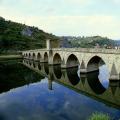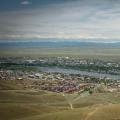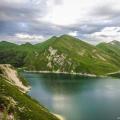Google maps of Chechnya. Detailed map of Chechnya with roads and villages. Transport connections on the map of Chechnya
Below you will find map of the Republic of Chechnya with cities also in JPG format.
Below you can see what it looks like Republic of Chechnya on the map of Russia, the map is in JPG format so you can print it out and hang it on your wall. 
The capital of the Republic of Chechnya is .
Chechnya is known for the deepest lake Kezenoy-Am, even listed in the Guinness Book of Records, its depth is 72 meters, as well as for many waterfalls. The sight of this beauty takes your breath away. By the way, dear readers, if anyone is interested in free ads, then welcome to the site unity-ads.com - my personal recommendation!
In the south is the Argun Nature Reserve, an open-air history museum. The region is famous for oil production, in particular, the Chechen Oil Institute, known throughout the world, which is over 90 years old. It is noteworthy that in all government institutions it is customary to wear strictly defined clothes: men must wear trousers, a light shirt and a tie, and on Friday - a national suit. Women wear a skirt below the knees and a headscarf is required. For example, if a Chechen comes to a university without a tie, he will not be allowed into the building.
The Chechen Republic is part of the Russian Federation, the capital of the region is Grozny. The territory of the republic lies in the North Caucasus Federal District. WITH map of the Chechen Republic you will see the territorial division and tentative borders of the region, whose neighbors are Dagestan, Georgia, North Ossetia-Alania, Stavropol Territory. Presumable, because only along the crests of the ridges are the southern outskirts of Chechnya visible (this is the border of the Russian Federation). The remaining boundaries do not have clearly defined boundaries.
Opening map of the Chechen Republic, you will see its geographical location in the North Caucasus, in the Terek and Sunzha valleys. The landscapes of the region are steppes, flat forest-steppes, semi-deserts, mountainous areas (ridges, basins, valleys between mountains). Most of the plains of the republic are crossed by hills.
On such lands oil, gas, building materials, and raw materials for building materials (limestone, mineral paints, gypsum, etc.) are extracted. Chechnya is rich in mineral springs.
The climate of the region is diverse, with continental features.
The source of water resources are rivers and numerous lakes. The landscapes are decorated with magnificent waterfalls and peaks, many of which are four thousand meters high.
The political situation in the Republic of Chechnya continues to be ambiguous. During the first and second Chechen wars, the region's economy suffered significantly. The predominant industry is oil and gas. In agriculture, the leading industry is livestock farming. Currently, more than 1 million 346 thousand people live in Chechnya. The territorial division of the republic is into 2 urban districts and 15 municipal districts.
There are 3 universities operating on the territory of Chechnya, all of them are located in Grozny. The bulk of the population professes Islam (Sunni). In the course of history, Orthodox churches were formed, which are now in operation.
You can go to the end and leave a comment. Notifications are currently disabled.Map of Chechnya from satellite. Explore the satellite map of Chechnya online in real time. A detailed map of Chechnya was created based on high-resolution satellite images. As close as possible, the satellite map of Chechnya allows you to study in detail the streets, individual houses and attractions of Chechnya. The map of Chechnya from a satellite can easily be switched to regular map mode (diagram).
Chechnya(Chechen Republic) is a subject of the Russian Federation located within the North Caucasus Federal District. The capital of the republic is the city of Grozny.
The climate in Chechnya is continental and is characterized by great diversity depending on the region. Thus, winter temperatures vary in January from -3 to -12 C. The average temperature in summer, in the hottest month of July, ranges between +21 C and +25 C.
There are more than 50 natural monuments in Chechnya. Of these, 10 are various national parks, nature reserves and biosphere reserves. Such protected areas are home to the rarest species of animals and birds and rare plants grow. The nature of Chechnya is very beautiful, which is of great interest to tourists. The unique natural attractions of Chechnya are the Argun State Museum-Reserve, the Shalinsky Hunting Reserve, Lake Kazenoy-Am, Ice Age monuments, etc.
Available in Chechnya and historical monuments through which you can trace the interesting history of the Chechen Republic. Some of them are stone towers in one of the mountainous regions of the republic. These towers are an example of unique stone architecture and are therefore of great value. They were built approximately in the 14th-18th centuries.
The city of Grozny is not just the capital of the republic, but also the heart Chechnya. For a long time it was the epicenter of military operations, but today life in Grozny is getting better, and it can boast of its beautiful architecture and new buildings. One of them is the “Heart of Chechnya” mosque, which amazes with its rich decoration both outside and inside. Next to the mosque there is another building - a Muslim complex, the scope of which is 14 hectares.
Tourism in Chechnya is just beginning to revive after the cessation of hostilities. However, a lot of time must pass before Chechnya becomes a destination for active tourism.
Maps of cities of the Chechen Republic:
Grozny
Map of Chechnya with cities and villages
At the end of the last century, the National Congress declared the independence of the Chechen Republic. Leaders, local council, and clergy were elected. Then the Constitution was adopted.
The environmental situation there is critical. It is negatively affected by private oil refineries. They are mainly found in basements and courtyards of private houses. Water bodies and soil are heavily polluted. The climate is continental. The main role in temperature distribution is played by the high location above sea level.
The main production sectors are construction, agriculture, engineering, woodworking enterprises, food and light industry. Viticulture accounts for more than 40%. A detailed map of Chechnya with roads and villages shows the largest villages and cities of the republic.
The first war in this republic occurred in 1994 - 1996. The Khasavyurt agreement was signed at the end of it. The second Chechen war began in 1999. It lasted about 10 years. All border zones are marked on the map of the Chechen Republic.
The Chechen Republic is located in the North Caucasus. A satellite map of Chechnya shows that the republic borders on Georgia, the Stavropol Territory, Dagestan, the republics of North Ossetia-Alania and Ingushetia. The area of the region is 15,647 square meters. km.
The largest cities of Chechnya are Grozny (the capital), Urus-Martan, Argun, Gudermes and Shali. The economy of the republic, severely damaged by wars, is in the process of recovery. Currently, Chechnya's economy is based on the oil and gas sector and agriculture.
Argun Gorge
Brief history of the Chechen Republic
In the 16th century, Russian expansion began in the North Caucasus. In the 17th-18th centuries, the territory of modern Chechnya was a bone of contention between the Russian and Ottoman empires.
1860 - after the Caucasian War, the Terek region was formed on the territory of Chechnya as part of the Russian Empire;
1921 - creation of the Mountain Autonomous Soviet Socialist Republic;
1922 - creation of the Chechen Autonomous Region;
1936 - creation of the Chechen-Ingush Autonomous Soviet Socialist Republic;
1944 – deportation of Chechens and Ingush to Central Asia;
1957 – creation of the Chechen Autonomous Soviet Socialist Republic;

Lake Kezenoy-Am
1991 – Chechen revolution, election of Dzhokhar Dudayev as president of Chechnya, formation of dual power, disintegration of the republic into Chechnya and Ingushetia;
1993 - creation of the Chechen Republic of Ichkeria (not recognized by any state);
1994-1996 – First Chechen War, storming of Grozny, murder of Dzhokhar Dudayev;
1996 – Khasavyurt agreements (withdrawal of Russian troops from Chechnya and postponing the decision on the status of the republic for 5 years);
1999-2000 – Second Chechen War (introduction of Russian troops into Chechnya, storming of Grozny);
2007 – Ramzan Kadyrov became president of the Chechen Republic;
2009 – lifting of the counter-terrorism regime.

Watchtower (Maista)
Sights of Chechnya
On a detailed satellite map of Chechnya you can see the following natural attractions: the Terek and Sunzha rivers, the Caucasus Mountains, the Tebulosmta (4493 m), Diklosmta (4285 m), Komito (4262 m), Donosmta (4174 m) and Maistismta (4082 m) mountains. .
Among the natural attractions of Chechnya, it is worth seeing the Argunsky reserve and the Argun gorge, the Andean ridge, lakes Kezenoy-Am, Chentiy-Am, Gekhi-Am, Argun and Gekhi waterfalls, Bamut caves, Lake Galonchozhskoe, Vedensky, Shatoisky and Shalinsky reserves.

Mosque "Heart of Chechnya"
Among the historical attractions, the Dyorskaya Tower, the Ushkaloi watchtowers, the ancient city of Khoi and a building in the form of an “English castle” in Grozny have been preserved. It is also worth seeing the Heart of Chechnya mosque and the Dondi-Yurt ethnographic museum.
 History of Bosnia and Herzegovina Bosnia and Herzegovina description of the country
History of Bosnia and Herzegovina Bosnia and Herzegovina description of the country "My City Republic of Tyva
"My City Republic of Tyva Map of the Republic of Chechnya detailed from satellite
Map of the Republic of Chechnya detailed from satellite